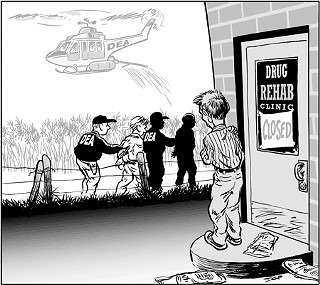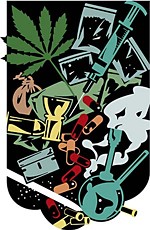Reefer Madness
New Fed Drug Budget, Same Blindness
By Jordan Smith, Fri., March 14, 2008
The numbers are in – and, once again, drug treatment and prevention programs are the big losers in the annual federal drug budget. Conversely, and not at all surprisingly, federal funding for narco-interdiction and other programs that focus on drug-supply reduction continue to be the big budget winners.
In other words, new year, same shit – and no progress, especially because supply-reduction is both really expensive and doesn't work very well. If the goal is actually to reduce drug availability and drug use, then wagering on supply-reduction to that purpose is a terrible bet. According to the government's own annual survey of drug use in America, the number of adults who admit to using drugs hasn't changed since 2002. That's right, we're holding steady: Annually, 20% of young adults (that is those 18-25) use drugs, as do 6% of adults 25 and older. (The number of addicts in need of treatment also remains steady, at just more than 22 million.)
But, hey, maybe this time, next year, all those billions in taxpayer funds will finally win the War on Drugs – right. Yet onward through the fog we go.
Among the highlights of President George W. Bush's proposed 2009 drug war spending: the Drug Enforcement Administration will receive $2.2 billion in funding (up from $1.9 billion in 2007); while $902 million will go to fund international anti-drug efforts – including $475 million proposed for the absurdly militaristic Plan Colombia. The plan includes aerial spraying of coca and poppy crops, which is tied to official assurances that the herbicides will be used "in accordance with Environmental Protection Agency label requirements." (I wish I were kidding.) To complete the vicious circle, Bush's budget offers a $50 million bump to expand federal prison capacity.
By bitter contrast, things aren't looking flush for drug treatment and prevention programs. The Substance Abuse & Mental Health Services Administration is facing a $198 million budget cut (overall, Bush has proposed cutting discretionary spending at the Department of Health & Human Services by $2.2 billion). The Center for Substance Abuse Treatment is budgeted to lose $63 million, while the Center for Substance Abuse Prevention would lose $36 million.
To be fair, Bush's budget does add $40 million for drug courts (cost-effective programs that divert low-level drug offenders from the criminal justice system); $56 million for emergency room and other health-care-system-initiated drug screening, "brief intervention," and treatment referrals; and an additional $98 million to "expand" drug-treatment capacity. These moderate increases sound like progress – until you consider that the prez has also seen fit to allot a whopping $204 million to fund "abstinence-only" sex education, which has proven about as effective a public health strategy as cocooning yourself in Saran Wrap against the flu.
A Sinking Ship
The proposed Bush budget again undercuts programs that might actually contribute to better public health – instead perpetuating the practice of treating drug use and addiction as primarily a law enforcement problem best addressed with handcuffs. After nearly 40 years of the War on Drugs, it remains true that simply punishing drug users does nothing to diminish drug use.
Drug-policy expert John Carnevale served in the White House budget office before moving over to the Office of National Drug Control Policy in the late Eighties. For years Carnevale was responsible for composing federal drug policy, including under President Bill Clinton, when he helped shift ONDCP policy toward more emphasis on demand-reduction. Carnevale says the gains made in the Nineties have slipped away under the leadership of current Bush czar John Walters. The prevention and treatment ship, "I think [is] sinking right now," Carnevale says. "I feel like we've gone back 30 years."
In the Eighties, he said, the office heavily emphasized stopping the importation of cocaine, "because we thought that would be the answer. It took awhile, but we learned that as long as there is a demand for illegal drugs, there will be a supply." By the time Clinton became president, there was an attempt to increase treatment and prevention efforts – but those efforts didn't take hold in Congress. Yet focusing primarily on supply-reduction is about as sensible as stoking a campfire with dollar bills.
In a recent policy paper, Carnevale notes that since fiscal year 2002, the federal drug budget has reverted to the Eighties approach, increasingly emphasizing funding for the "least effective ingredients" of drug policy. "For the federal drug control policy to be most effective, it must both be evidence-based and supported by a budget specifically designed to implement it," Carnevale writes. However, in the current decade, the feds have "not funded programs that research suggests would be more effective in reducing drug demand and its associated damaging consequences. Simply stated, the federal drug budget trend runs counter to what research would otherwise suggest is necessary for an effective drug control policy."
Money for Nothing
Drug control policy is made up of five key ingredients: treatment, prevention, law enforcement, interdiction, and "source country" supply-reduction programs (for example, trying to reduce economic reliance on coca growing in Colombia by helping develop viable agricultural alternatives). "The art of developing the most effective drug policy," Carnevale writes, "involves taking the evidence that research has to offer regarding each of these main ingredients and applying it to come up with the best" budget mix.
Which of the five ingredients does research suggest are the "truly most effective" elements of drug policy? If you said "treatment and prevention," you are now, officially, smarter than your government. Carnevale's review of federal drug-policy funding since Fiscal Year 2002 reflects that government spending has overwhelmingly emphasized the funding of the least effective policy ingredients. Funding for interdiction – programs that seek to stop drugs from entering the country – increased 100% from FY 2002 to FY 2009, from about $1.9 billion to $3.8 billion; funding for international source-country supply-reduction programs increased nearly 50%; and funding for domestic drug-war law enforcement grew by 31%. Conversely, spending for treatment (and treatment research) has grown by just 22%, while funding for drug-use prevention programs (and prevention research) has actually declined by more than 24%. Overall, funding for supply-reduction programs is up 57% since FY 2002, while demand-reduction funding has increased just 3%. Indeed, supply-reduction programs eat up more than two-thirds of the entire federal drug policy budget.
Carnevale remains hopeful that things may change – once Bush leaves office and Walters is out the door. Carnevale's goal now, he said, is to be more vocal about the way things could be: "Realizing that this administration is leaving, I am trying to say things to get the next administration thinking about what to do about drug policy," he said last week. But "there's no silver bullet in this business," he said. "We've all learned that."
Got something to say on the subject? Send a letter to the editor.











